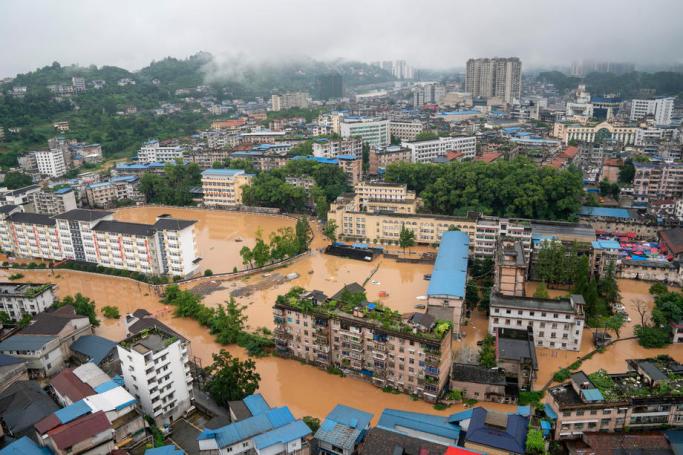Over the past few weeks, several regions in southern, eastern and central China have experienced torrential rain and large-scale flooding. Affected regions include Hubei province, where Wuhan—the epicentre of the ongoing COVID-19 pandemic—is located. On 12 July, China’s Ministry of Emergency Management upgraded the emergency alert level from III to II. So far, 140 people have died and over 200,000 people have been displaced from affected towns where the floods have damaged houses and other infrastructure. Overall, an estimated 37 million people have been affected by these floods. Economic losses arising from this is estimated to be around US$ 3 billion and might rise further if the situation continues.
Several cities are located downstream from China’s many dams which have been releasing floodwater over the past few days. Most of these cities have also experienced flooding and associated damage and disruption. These floods, the increased amounts of water currently being discharged from dams in China, and satellite imagery have raised concerns regarding the structural stability of dams in China, especially the Three Gorges Dam (TGD), among other such infrastructures.
Initially in June 2020, China had claimed that opening of the dam’s spillways to discharge water was for electricity generation purposes. Some days later, Beijing stated that the water release was a part of emergency floodwater discharge. However, while the annual flood season in this part of China only begins around July, Chinese dams have been discharging floodwater since early June 2020, with official sources citing rainfall as the reason, and accusing ‘foreign forces’ of trying to ‘tarnish’ the dam and the Chinese government’s image. Any problems with the TGD could directly impact at least 35 major cities that are located along the Yangtse river, and many other regions and smaller cities and towns that are located along the river’s basin.
The release of these floodwaters from the dams has already compounded flooding in downstream regions, displacing thousands and affecting millions. Furthermore, these floods and the heavy rains have resulted in large parts of cities and towns getting partially submerged, several cave-ins of roads and buildings, and severe damage to a variety of physical infrastructure in all these regions, bringing life to a grinding halt. As a result, locals in China have been raising questions regarding the TGD’s structural integrity, and whether the flood water release has something to do with the dam’s structural weaknesses. Although greater clarity is needed, the locals’ doubts are not entirely unfounded.
Right from the start, the TGD, which is located in Hubei Province, was already controversial due to its overly ambitious objective and associated massive environmental risks. Based on sheer capacity, the TGD, which became fully operational (i.e. including with electricity generation capabilities) in 2012, is currently the world’s largest power plant. However, the structural integrity of this dam has always been questionable. For example, shortly after the reservoir was filled up for the first time, approximately 80 cracks appeared on the dam. Scholars have also stated that the construction of this dam has also contributed to exacerbating seismic activity (such as earthquakes) as well as droughts in lower riparian regions. Even as far back as 2011, the Chinese government had admitted to the scale and scope of threats posed by the TGD. For instance, during a State Council Executive Meeting, Chinese officials admitted that the TGD had ‘some urgent problems’ with regard to ‘ecological environmental protection, and geological disaster prevention’. Even as recently as June
2020, scholars and scientists raised red flags regarding the structural integrity of the TGD, but Beijing denied those claims.
The doubts regarding the structural integrity of the TGD also give rise to questions regarding the quality and durability of Chinese mega infrastructure construction projects abroad. Beijing has initiated or supported several construction projects of dams etc in many countries in Asia and Africa under the Belt and Road Initiative (BRI).
If China’s own major dam in its own country is structurally unsound, how safe might the dams constructed by Chinese enterprises in foreign countries be? Moreover, what would happen if a situation like the one ongoing in China occurs in the downstream areas of dams in those foreign countries? Given how many of the BRI mega infrastructure projects are being conducted in developing countries with relatively lesser economic strengths, would they be able to recover from the massive human and economic losses that such disasters might bring with them.
Lee Chen in the pseudonym for a writer who covers Asian affairs












